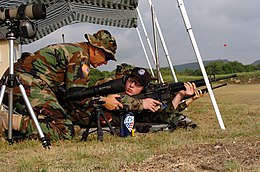Interwar period and World War II
The Organized Reserve infantry divisions raised immediately after World War I generally continued the lineage and geographic area distribution of National Army divisions that had served in the war. They were maintained on paper with a maximum of all of their officers and one-third of their enlisted men. Units in other arms of the Army besides infantry were also maintained, such as field artillery, coast artillery, cavalry, engineers, medical, signal, quartermaster, and ordnance. In March 1926, the War Department authorized the manning of Regular Army units being maintained in an "inactive" status with Organized Reserve officers, eliminating the previously-used "Active Affiliate" program for these units. Nearly all "Regular Army Inactive" (RAI) infantry regiments and many other units were "affiliated" with Reserve Officers Training Corps (ROTC) units in their vicinity, with the professor of military science and tactics at the school or the senior Regular Army officer of the unit's branch assigned to the ROTC program serving as the unit commander. By 1 October 1933, command of all RAI units had been turned over to Reserve officers. A number of the affiliations became defunct throughout the 1930s, but RAI units were among the most active in the Reserves. [9] [10]
The ultimate use of Organized Reserve units and personnel remained unclear in the interwar period. While Army regulations stated that "The ultimate objective in training units of the Organized Reserve in time of peace is to provide partially trained units which may be readily expanded to war strength and completely trained in time of emergency," historian William J. Woolley wrote that, "The question of whether reserve units were to be chiefly concerned with mobilizing and training a conscripted citizen army or were to be contingents of a nearly ready combat force was never resolved in the 1930s, and reforms in training efforts often shifted between one and the other of the two objectives." Service in the Organized Reserve during the interwar period was not as appealing as the Army expected, and suffered because of limited funding that restricted training opportunities. Turnover in the Officers' Reserve Corps was high, as many men in mandatory ROTC had little interest in military affairs, and allowed their five-year commissions to expire without applying for reappointment. By the beginning of the 1930s, ROTC graduates became the single largest cohort of officers in the Officers' Reserve Corps. [11]
The original Regular Army Reserve, established in 1916 but abolished in 1920, had chiefly been manned by the reenlistment of former Regular Army soldiers or National Guardsmen, but the small annual stipend as an incentive for joining was not included in the Enlisted Reserve Corps (ERC). Another problem with the Enlisted Reserve Corps was the few avenues through which someone could join. Enlistment in the ERC was restricted to those men "who have had such military or technical training as may be prescribed by regulations of the Secretary of War." One means to join the ERC was through the ROTC or Citizens Military Training Camps (CMTC). If a man had completed at least one year in ROTC, or had completed one 4-week CMTC camp, he could also enlist in the ERC. Each year of participation in ROTC and completion of each CMTC camp earned the participant promotions in the ERC. Some enlisted reservists went on to receive commission in a few years, thus leaving the ranks of the ERC. The final way one could enter the ERC was if he (or she, in the case of nurses) possessed skills needed by the Army that required no prior military training, such as nursing, railroad occupations, certain communications fields, and music. Interestingly, a substantial number of enlisted reservists in the interwar period, at least into the early 1930s, were bandsmen. Because of these restrictions, the ERC maintained an average strength of only about 3,500 men and women, and never more than 6,000 at any time from 1919 to 1941; most divisions reached their full complement of officers but had less than 100 enlisted men. [12]
The extent of prewar mobilization--"a state neither of war nor of peace"—disrupted the Organized Reserve. Beginning in mid-1940, large numbers of Reserve officers began to be called to active duty individually and assigned to expanding Regular Army units, and to National Guard units after the mobilization of that component was authorized in August. On 30 June 1940, 2,710 Reserve officers were on active duty, but by 15 May 1941, the number was over 46,000, and by 30 June, 57,309. The need for young, qualified company-grade officers was acute, and by mid-1941, 75 to 90 percent of the officers in Regular Army units and 10 percent in National Guard units were Reserve officers. By December 1941, 80,000 Reserve officers were on active duty. By the end of 1942. 140,000 officers holding Reserve commissions through various paths were on active duty, but by that date, 12,100 "had not received such orders," mainly for reasons like being over-age in grade, found medically disqualified for active service, deferred due to academics or civilian employment, or lack of vacancies.
On 6 February 1942, President Franklin D. Roosevelt signed Executive Order 9049, which ordered "into the active military service of the United States...for the duration of the present war and for six months after the termination thereof...each of the organizations and units and all of the personnel of the Organized Reserves not already in such service." Because of the course of the mobilization of 1940–1941, "few of the Reserve officers originally assigned to...units were available for duty with them. Consequently, the units as activated bore small resemblance to those of peacetime." [13] The order and timetable in which Organized Reserve infantry divisions were ordered to active duty was based upon the number of World War I battle honors earned, if applicable, the location and availability of training sites, and the ability of the Army to furnish divisional cadres and filler replacements.
| Division | States Represented in Interwar Period | Campaign Participation Credit |
|---|

76th Infantry Division | Connecticut, Rhode Island | Rhineland, Ardennes-Alsace, Central Europe |
|---|

77th Infantry Division | New York | Western Pacific, Southern Philippines, Ryukyus |
|---|

78th Infantry Division | Delaware, New Jersey | Rhineland, Ardennes-Alsace, Central Europe |
|---|

79th Infantry Division | Pennsylvania | Normandy, Northern France, Rhineland, Central Europe |
|---|

80th Infantry Division | Maryland, Virginia, Washington, D.C. | Normandy, Northern France, Rhineland, Ardennes-Alsace, Central Europe |
|---|

81st Infantry Division | North Carolina, Tennessee | Western Pacific, Southern Philippines |
|---|

82nd Airborne Division | Florida, Georgia, South Carolina | Sicily, Naples-Foggia, Normandy, Rhineland, Ardennes-Alsace, Central Europe |
|---|

83rd Infantry Division | Ohio | Normandy, Northern France, Rhineland, Ardennes-Alsace, Central Europe |
|---|

84th Infantry Division | Kentucky | Rhineland, Ardennes-Alsace, Central Europe |
|---|

85th Infantry Division | Michigan | Rome-Arno, North Apennines, Po Valley |
|---|

86th Infantry Division | Illinois | Central Europe |
|---|

87th Infantry Division | Alabama, Louisiana, Mississippi | Rhineland, Ardennes-Alsace, Central Europe |
|---|

88th Infantry Division | Iowa, Minnesota, North Dakota | Rome-Arno, North Apennines, Po Valley |
|---|

89th Infantry Division | Kansas, Nebraska, South Dakota | Rhineland, Central Europe |
|---|

90th Infantry Division | Texas | Normandy, Northern France, Rhineland, Ardennes-Alsace, Central Europe |
|---|

91st Infantry Division | California | Rome-Arno, North Apennines, Po Valley |
|---|

94th Infantry Division | Massachusetts | Northern France, Rhineland, Ardennes-Alsace, Central Europe |
|---|

95th Infantry Division | Oklahoma | Northern France, Rhineland, Central Europe |
|---|

96th Infantry Division | Oregon, Washington | Leyte, Southern Philippines, Ryukyus |
|---|

97th Infantry Division | Maine, New Hampshire, Vermont | Central Europe |
|---|

98th Infantry Division | New York | No combat |
|---|

99th Infantry Division | Pennsylvania | Rhineland, Ardennes-Alsace, Central Europe |
|---|

100th Infantry Division | Kentucky, West Virginia | Rhineland, Ardennes-Alsace, Central Europe |
|---|

102nd Infantry Division | Arkansas, Missouri | Rhineland, Central Europe |
|---|

103rd Infantry Division | Arizona, Colorado, New Mexico | Ardennes-Alsace, Rhineland, Central Europe |
|---|

104th Infantry Division | Idaho, Montana, Nevada. Utah, Wyoming | Rhineland, Ardennes-Alsace, Central Europe |
|---|
The 101st Infantry Division was designated a division of the Organized Reserve after World War I and assigned to the state of Wisconsin; unlike the 82nd Airborne Division, the Reserve division was disbanded when the 101st Airborne Division was raised in the Army of the United States on 15 August 1942.
Cold War
A tentative troop basis for the Organized Reserve Corps (ORC), prepared in March 1946, outlined 25 divisions: three armored, five airborne, and 17 infantry. [14] These divisions and all other Organized Reserve Corps units were to be maintained in one of three strength categories, labeled Class A, Class B, and Class C. Class A units were divided into two groups, one for combat and one for service, and units were to be at required table of organization strength; Class B units were to have their full complement of officers and enlisted cadre strength; and Class C were to have officers only. The troop basis listed nine divisions as Class A, nine as Class B, and seven as Class C.
Major General Ray E. Porter therefore proposed reclassification of all Class A divisions as Class B units. Eventually the War Department agreed and made the appropriate changes. Although the dispute over Class A units lasted several months, the War Department proceeded with the reorganization of the Organized Reserve Corps divisions during the summer of 1946. That all divisions were to begin as Class C (officers only) units, progressing to the other categories as men and equipment became available, undoubtedly influenced the decision. Also, the War Department wanted to take advantage of the pool of trained reserve officers and enlisted men from World War II. By that time Army Ground Forces had been reorganized as an army group headquarters that commanded six geographic armies. The armies replaced the nine corps areas of the prewar era, and the army commanders were tasked to organize and train both Regular Army and Organized Reserve Corps units.
The plan the army commanders received called for twenty-five Organized Reserve Corps divisions, but the divisions activated between September 1946 and November 1947 differed somewhat from the original plans. The First United States Army declined to support an airborne division, and the 98th Infantry Division replaced the 98th Airborne Division. After the change, the Organized Reserve Corps had four airborne, three armored, and eighteen infantry divisions. The Second Army insisted upon the number 80 for its airborne unit because the division was to be raised in the prewar 80th Division's area, not that of the 99th. Finally, the 103rd Infantry Division, organized in 1921 in New Mexico, Colorado, and Arizona, was moved to Iowa, Minnesota, South Dakota, and North Dakota in the Fifth United States Army area. The Seventh Army (later replaced by Third Army), allotted the 15th Airborne Division, refused the designation, and the adjutant general replaced it by constituting the 108th Airborne Division, which fell within that component's list of infantry and airborne divisional numbers. Thus the final tally of divisions formed after World War II appears to have been the 19th, 21st, and 22d Armored Divisions; the 80th, 84th, 100th and 108th Airborne Divisions; and the 76th, 77th, 79th, 81st, 83rd, 85th, 87th, 89th, 90th, 91st, 94th, 95th, 96th, 97th, 98th, 102nd, 103rd, and 104th Infantry Divisions.
A major problem in forming divisions and other units in the Organized Reserve Corps was adequate housing. While many National Guard units owned their own armories, some dating back to the nineteenth century, the Organized Reserve Corps had no facilities for storing equipment and for training. Although the War Department requested funds for needed facilities, Congress moved slowly in response. The Organized Reserves were redesignated 25 March 1948 as the Organized Reserve Corps. Recognizing the importance of the Organized Reserve to the World War II effort, Congress authorized retirement and drill pay for the first time in 1948.
During the summer and fall of 1951 the six army commanders in the United States, staff agencies, and the Section V Committee (created after World War I for the reserve components to have a voice in their affairs), evaluated Department of the Army reorganization plans for the ORC. The army commanders urged that all divisions in the Organized Reserve Corps be infantry divisions because they believed that the reserves could not adequately support armored and airborne training. [15] They thought thirteen, rather than twelve, reserve divisions should be maintained to provide a better geographic distribution of the units. The Section V Committee opposed the reduction of the Organized Reserve Corps from twenty-five to thirteen divisions because it feared unfavorable publicity, particularly with the nation at war. On 20 December the Vice Chief of Staff of the United States Army, General John E. Hull, directed the reorganization and redesignation of airborne and armored divisions as infantry as soon as practicable. In March 1952 the 80th, 84th, 100th, and 108th Airborne Divisions were reorganized and redesignated as infantry divisions, and the 63d, 70th, and 75th Infantry Divisions replaced the 13th, 21st, and 22d Armored Divisions.
Before the dust had settled on the reforms, the Army realized that it had failed to improve unit manning or meet reasonable mobilization requirements. In the fall of 1952 Army leaders thus proposed that the personnel from the thirteen inactivated Army Reserve divisions be assigned to strengthen the remaining twelve divisions. To keep the unneeded fifteen Army Reserve divisions active, they were to be reorganized as training divisions to staff training centers upon mobilization or man maneuver area commands for training troops. The continental army commanders implemented the new Army Reserve troop basis in 1955 piecemeal. They reorganized, without approved tables of organization, the 70th, 76th, 78th, 80th, 84th, 85th, 89th, 91st, 95th, 98th, 100th, and 108th Infantry Divisions as cadre for replacement training centers and organized the 75th "Maneuver Area Command" using the resources of the 75th Infantry Division. Two years later the 75th Infantry Division was inactivated along with 87th Infantry Division. Assets of the 87th were used to organize a maneuver area command; thus one unneeded division remained in the troop basis.
While the Korean War was still underway, Congress began making significant changes in the structure and role of the Army Reserve. These changes transformed the Organized Reserve into the United States Army Reserve, from 9 July 1952. [16] This new organization was divided into a Ready Reserve, Standby Reserve, and Retired Reserve. Army Reserve units were authorized twenty-four inactive duty training days a year and up to seventeen days of active duty (called annual training).
In 1959 the Army decided to realign National Guard and Army Reserve divisions under Pentomic structures. Secretary of Defense Neil H. McElroy decided on 10 Army Reserve divisions. By October 1959 ten Army Reserve infantry divisions completed their transition, but at a reduced strength. The eleventh combat division in the Army Reserve, the 104th, was converted to training, for a total of thirteen training divisions, all of which were in the Army Reserve.
To reorganize the Army Reserve to the new Reorganization of Army Divisions (ROAD) structures in the early 1960s, the Army Staff decided to retain one Army Reserve division in each of the six Army areas and to eliminate four divisions. Army commanders selected the 63d, 77th, 81st, 83d, 90th, and 102d Infantry Divisions for retention and reorganized them under ROAD by the end of April 1963. Each division had two tank and six infantry battalions.
With the elimination of the 79th, 94th, 96th, and 103d Infantry Divisions, the Army decided to retain their headquarters as a way to preserve spaces for general and field grade officers. It reorganized the units as operational headquarters (subsequently called command headquarters [division]) and directed them to supervise the training of combat and support units located in the former divisional areas and to provide for their administrative support. Some former divisional units assigned to the four divisions were used to organize four brigades, which added flexibility to the force as well as provided four general officer reserve billets. In January and February 1963 the 157th, 187th, 191st, and 205th Infantry Brigades were organized with headquarters in Pennsylvania, Massachusetts, Montana, and Minnesota, respectively. [17] The designation of each brigade was derived from the lowest numbered infantry brigade associated with the division under the square structure. As with the Regular Army brigades, the number and type of maneuver elements in each Army Reserve brigade varied.
In November 1965, a long-standing controversial goal of the Defense Department, a reduction of the reserve troop basis, was achieved. Those reserve units that were judged unnecessary and others that were undermanned and underequipped were deleted and their assets used to field contingency forces. Among the units inactivated were the last six combat divisions in the Army Reserve, the 63d, 77th, 81st, 83d, 90th, and 102d Infantry Divisions, and the 79th, 94th, and 96th Command Headquarters (Division). The 103d Command Headquarters (Division) was converted to a support brigade headquarters.
A number of U.S. Army Reserve corps headquarters were disestablished on 31 March 1968. They were reorganized as Army Reserve Commands.
In 1980, the peacetime USAR chain of command was overlaid with a wartime trace. In an expansion of the roundout and affiliation programs begun ten years earlier, CAPSTONE purported to align every Army Reserve unit with the active and reserve component units with which they were anticipated to deploy. [18] Units maintained lines of communication with the units – often hundreds or thousands of miles away in peacetime – who would presumably serve above or below them in the event of mobilization. This communication, in some cases, extended to coordinated annual training opportunities.
Despite the commonly held belief that CAPSTONE traces were set in stone, the process of selecting units to mobilize and deploy in 1990 and 1991 in support of Operation Desert Shield and Desert Storm frequently ignored CAPSTONE. [19]




















